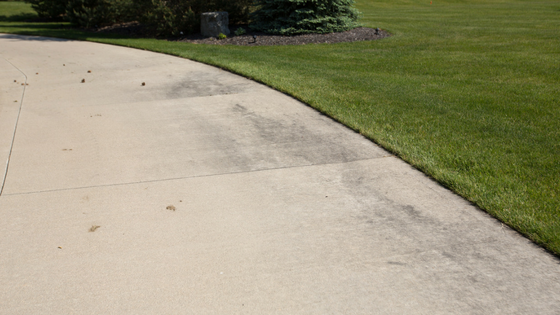
You’ve fired up the power washer, blasted your driveway or patio with full force, and watched layers of dirt peel away… but after everything dries, your concrete still looks stained or grimy. 😤 Frustrating, right?
If you’re wondering, “Why is my concrete still dirty after power washing?” — you’re not alone. This is a common question, and the answer often lies in technique, expectations, and what type of “dirt” you’re dealing with.
In this article, we’ll cover why your concrete might still look dirty after pressure washing, the most common culprits behind stubborn stains, and what you can do to finally get that spotless look you were aiming for. 🧽✅
🧼 First, Let’s Talk About Expectations
Many homeowners believe pressure washing is a magic solution that restores concrete to a bright, uniform color — but not all stains are created equal. Power washing can absolutely remove:
✅ Surface dirt
✅ Dust and pollen
✅ Loose debris
✅ Algae and mildew (to an extent)
However, it’s not always effective against:
❌ Deep oil stains
❌ Rust or mineral deposits
❌ Mold that has rooted below the surface
❌ Concrete discoloration due to age or damage
In short, if your stains are below the surface or chemical in nature, a standard power wash alone won’t be enough. But don’t worry — there are solutions. 💡
🕵️ Top Reasons Your Concrete Still Looks Dirty
1. Deep or Set-In Stains
Concrete is porous, which means liquids like oil, grease, rust, and even wine can seep in and stain from within. Pressure washing can’t always reach deep enough to remove them completely.
Fix it: Use a targeted stain remover:
- Degreaser for oil or tire marks
- Rust remover with oxalic acid
- Concrete brightener for old or dull concrete
Let the cleaner sit per instructions before rinsing thoroughly.
2. Mold or Mildew Has Grown Beneath the Surface
Green or black staining often indicates mold, moss, or mildew, especially in shady or damp areas. A pressure washer may clean the surface, but mold spores can still remain in the pores.
Fix it: Apply a mold-killing detergent or diluted bleach solution (carefully). Scrub with a brush, let sit, then rinse. For stubborn cases, a second round may be necessary.
3. Mineral Buildup or Efflorescence
That white, chalky residue you see? That’s efflorescence — salt deposits brought to the surface by moisture in the concrete. Power washing might not dissolve it.
Fix it: Use an acid-based concrete cleaner (like muriatic acid or vinegar solutions). Rinse thoroughly afterward and wear protective gear.
4. Uneven Cleaning or Striping
Sometimes, what looks like a “dirty” spot is actually a missed or unevenly cleaned section. Using inconsistent strokes or standing too far from the surface can lead to streaks.
Fix it: Go back over the area using overlapping passes. A surface cleaner attachment helps distribute pressure evenly across flat concrete for streak-free results.
5. Old, Weathered Concrete
Concrete naturally darkens and changes color over time due to UV exposure, weather, and general wear. What you see may not be “dirt” at all — it could be permanent discoloration or erosion.
Fix it: If it really bothers you, consider:
- Concrete brighteners
- Staining or painting the surface
- Resurfacing for a fresh finish
6. Residual Detergent or Soap
If you used detergent or degreaser and didn’t rinse well enough, soap residue can attract dirt and leave streaks once it dries.
Fix it: Rinse again using low pressure and plenty of clean water. A final rinse helps flush out any remaining suds or film.
7. Oil or Grease Seepage After Cleaning
You might’ve removed the surface layer of oil, but deep-seated oil can continue to rise back up over time, especially in garages or driveways.
Fix it: Use repeated degreasing treatments or a poultice cleaner that draws out contaminants. You may need to clean the area more than once over several days.
🧪 Should You Use a Chemical Cleaner?
Absolutely — if you’re dealing with stubborn grime. Here are a few recommended options:
| Stain Type | Cleaner Type |
|---|---|
| Oil & Grease | Degreaser or enzyme-based cleaner |
| Rust | Oxalic acid-based rust remover |
| Mold & Mildew | Sodium hypochlorite or mold-specific spray |
| Efflorescence | Muriatic acid or efflorescence remover |
| General Dirt | Concrete detergent or mild alkaline cleaner |
⚠️ Safety Tip: Always spot-test your cleaner, and wear gloves, eye protection, and a mask when using strong chemicals.
Browse Amazon Here For Popular Power Washing Detergents
💡 Pro Tips for a Cleaner Result Next Time
- Pre-treat tough stains before power washing
- Use a rotating surface cleaner attachment for even coverage
- Apply detergent and let it dwell for 5–10 minutes before rinsing
- Use a PSI of 2,500–3,000 for most concrete cleaning
- Avoid cleaning in full sunlight to reduce streaking or drying too fast
- Seal your concrete after cleaning to protect from future stains
✅ Final Takeaway
If your concrete still looks dirty after power washing, don’t be discouraged. Most likely, the stains are:
- Set deep into the surface
- Chemical or biological in nature
- Or caused by improper technique
With the right cleaner, equipment, and technique, you can still achieve that clean, fresh look you were hoping for. Power washing is just the first step — targeted treatments and follow-up care make all the difference. 🧱✨🧼
Browse Amazon Here For Top Rated Power Washers And Accessories






